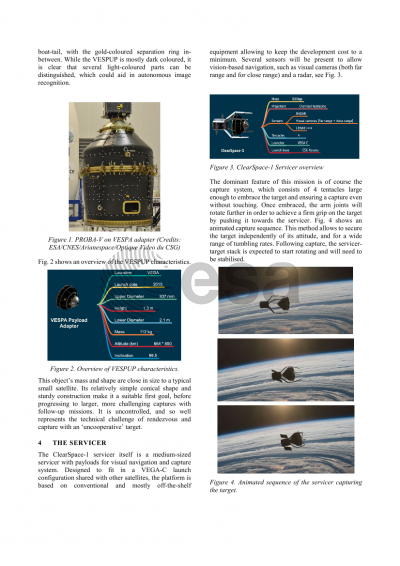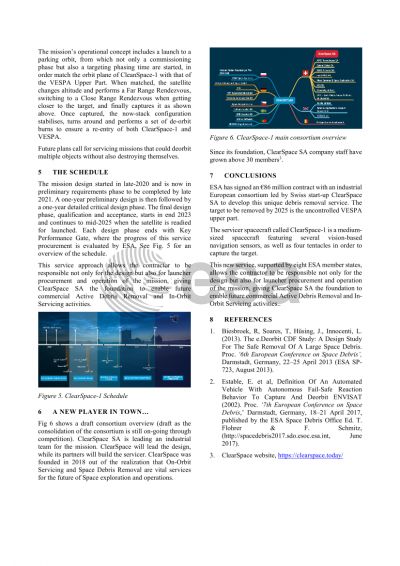Document details

Abstract
During the 2019 ESA Council at Ministerial Level, Space Safety was adopted as a new basic pillar of ESA’s activities, including the first space mission to remove an item of debris from orbit. As a result, ESA has signed an €86 million contract with an industrial European consortium led by Swiss start-up ClearSpace SA to develop this unique debris removal service. The objectives of this mission are to 1) clean up space, 2) demonstrate the technologies needed for debris removal, and 3) open a new market for in-orbit servicing and debris removal.
The target to be removed is an ESA owned VESPA (VEGA Secondary Payload Adapter) upper part, launched in 2013. It orbits the Earth in a slightly eccentric orbit (664 km x 800 km). VESPA’s mass and dimensions, 112 kg, 1.3m height and 2.1m maximum diameter, make it a representative object for possible future debris removals of for example large constellations.
The mission’s operational concept includes a launch to a parking orbit, from which not only a commissioning phase but also a targeting phasing time are started, in order match the orbit plane of CleanSpace-1 with that of the VESPA Upper Part. When matched, the satellite changes altitude and performs a Far Range Rendezvous, switching to a Close Range Rendezvous when getting closer to the target. A set of four tentacles will deploy, which will capture the VESPA Upper Part by embracing it. This method allows to secure the target independently of its attitude, and for a wide range of tumbling rates. Once captured, the now-stack configuration stabilises, turns around and performs a set of de-orbit burns to ensure a re-entry of both ClearSpace-1 and VESPA.
The mission design started in mid-2020 and is now in preliminary requirements phase to be completed mid of 2021. A one-year preliminary design is then followed by a one-year detailed critical design phase. The final design phase, qualification and acceptance, starts in end 2023 and continues to mid-2025 when the satellite is readied for launched. Each design phase ends with Key Performance Gate, where the progress of this service procurement is evaluated by ESA.
This new service, supported by eight ESA member states, allows the contractor to be responsible not only for the design but also for launcher procurement and operation of the mission, giving ClearSpace SA the foundation to enable future commercial Active Debris Removal and In-Orbit Servicing activities.
Preview




